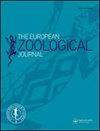一个伟大的小盟友:揭示蚜虫捕食者的未成熟阶段的形态(Wiedemann, 1830)(双翅目:蚜科)
IF 1.4
4区 生物学
Q2 ZOOLOGY
引用次数: 1
摘要
在成虫和幼虫阶段的形态学对于正确识别昆虫和更好地理解昆虫的生物学和行为至关重要。昆虫形态功能信息的缺乏在未成熟阶段比在成虫阶段更为普遍,主要昆虫目,如双翅目也不例外。食蚜虫属(双翅目:食蚜科)包括许多属,其食蚜幼虫在自然和农业系统中都起着控制害虫的关键作用。rueppellii (Sphaerophoria rueppellii, Wiedemann, 1830)是一种广泛分布于古北地区的食蚜虫,作为一种生物防治蚜虫具有重要的商业价值。然而,对其未成熟阶段的精细形态知之甚少,因为它是在1939年被描述的,当时的显微镜还不能详细研究某些形态特征。在这项工作中,使用立体显微镜和扫描电子显微镜(SEM)来获得更深入和更详细的幼体形态图。利用扫描电镜(SEM)详细观察了三种幼虫的毛分异、幼虫/蛹后呼吸过程(PRP)和卵的绒毛膜结构。我们首次描述了虫卵、第一幼虫和第二幼虫阶段,并对第三幼虫和蛹进行了完整的更新描述。这三种幼虫在感受器数量、PRP形态、颜色和体型等方面各不相同。测定了卵绒毛膜和蛹被的厚度。对感受器数量变化的原因的一种可能解释进行了讨论。提供了鲁氏螺旋体卵、幼虫和蛹的图解和完整描述,包括第三幼虫期的头部骨架。本文章由计算机程序翻译,如有差异,请以英文原文为准。
A great little ally: revealing the morphology of the immature stages of the aphid pest predator Sphaerophoria rueppellii (Wiedemann, 1830) (Diptera: Syrphidae)
Abstract Morphology, at both adult and larval stages is crucial for the correct identification of an insect and a better understanding of its biology and behaviour. The lack of morpho-functional information in insects is much more general in the immature stages than in adults, and major insect orders, such as Diptera are no exception. Syrphids (Diptera: Syrphidae) include various genera with aphidophagous larvae playing a key role in the control of pest insects in both natural and agricultural systems. The aphidophagous Sphaerophoria rueppellii (Wiedemann, 1830) is a syrphid widely distributed in the Palearctic Region and it is of commercial importance as a biological control agent against aphid pests. However, little is known about the fine morphology of its immature stages because it was described in 1939, when microscopy did not allow detailed studies of certain morphological features. In this work, stereomicroscope and scanning electron microscopy (SEM) were used to get a deeper and more detailed picture of the immature stage morphology of this syrphid. SEM was used to examine in detail the chaetotaxy of three larval instars, the larva/puparium posterior respiratory process (PRP), and the chorionic structure of the egg. We describe for the first time the egg, first and second larval stages, and also give a complete updated description of the third-stage larva and the puparium. The three larval instars vary from each other, especially in the number of sensillae, PRP form, colour, and body size. The thickness of both the egg chorion and puparium integument were also measured. A possible interpretation of the reasons for the variability in the number of sensillae is discussed. Illustrations and full descriptions are provided for the egg, larva, and puparium of S. rueppellii, including the head skeleton of the third larval stage.
求助全文
通过发布文献求助,成功后即可免费获取论文全文。
去求助
来源期刊

European Zoological Journal
Agricultural and Biological Sciences-Animal Science and Zoology
CiteScore
3.10
自引率
5.60%
发文量
80
审稿时长
30 weeks
期刊介绍:
The European Zoological Journal (previously Italian Journal of Zoology) is an open access journal devoted to the study of all aspects of basic, comparative and applied protozoan and animal biology at molecular, cellular, tissue, organ, organismal, population, and community-ecosystem level. Papers covering multiple levels of organization and integrative approaches to study animal form, function, development, ecology, evolution and systematics are welcome. First established in 1930 under the name of Il Bollettino di Zoologia, the journal now has an international focus, reflected through its global editorial board, and wide author and readership.
 求助内容:
求助内容: 应助结果提醒方式:
应助结果提醒方式:


